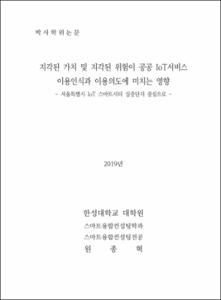지각된 가치 및 지각된 위험이 공공 IoT서비스 이용인식과 이용의도에 미치는 영향
= Effects of Perceived Values and Perceived Risks on Public IoT Services Use Recognition and Use Intention
- Type
- Thesis
- Alternative Title
- 서울특별시 IoT 스마트시티 실증단지 중심으로
- Department
- 대학원 스마트융합컨설팅학과
- Issued Date
- 2018
- Publisher
- 한성대학교 대학원
- Appears in Collections:
- 스마트융합컨설팅학과 > 1. Thesis
- Files in This Item:
-
-
Download
 200000173404.pdf
기타 데이터 / 3 MB / Adobe PDF
200000173404.pdf
기타 데이터 / 3 MB / Adobe PDF
-
Items in Repository are protected by copyright, with all rights reserved, unless otherwise indicated.